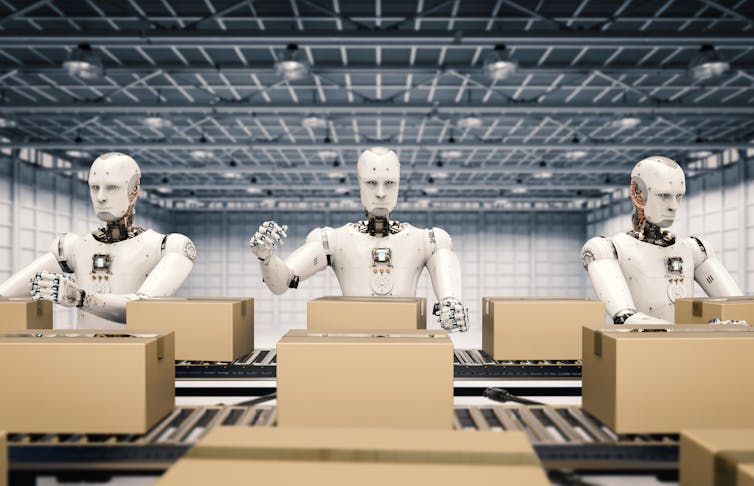How the ‚Äėrobot revolution‚Äô is changing jobs and businesses in Canada
February 23, 2021
Share

In 2017, I returned to Canada from Sweden, where I had spent a year working on . Shortly after my return, the New York Times published a piece called, ‚Äú,‚ÄĚ about Sweden‚Äôs embrace of automation while limiting human costs.
 Although Swedes are apparently optimistic about their future alongside robots, other countries aren’t as hopeful. One widely cited .
Although Swedes are apparently optimistic about their future alongside robots, other countries aren’t as hopeful. One widely cited .
Whether we like it or not, the robot era is already upon us. The question is: Is the Canadian economy poised to flourish or flounder in a world where robots take over the tasks we don’t want to do ourselves? The answer may surprise you.
Robots are everywhere
Modern-day are how artificial intelligence (AI) physically interacts with us, and the world around us. Although some robots , most do not and are instead specifically designed to autonomously carry out complex tasks.
Over the last few decades, robots have rapidly grown from specialized devices developed for select industry applications to household items. You can buy a robot to , and . Kids play with at school, where they learn to code, and compete in robot design teams that culminate in .
Robots are also appearing in our hospitals, promising to help us and performing in safer and more efficient ways.
The media is abuzz with stories about the latest technical claims, rumours and speculations about the secret developments of major international corporations, including , , , and .
And NASA just landed the on Mars, with an autonomous helicopter called attached to its belly.
Oh, and there are the too, of course.
Robots behind the scenes
I have been working on robotics and autonomous vehicles technology since the late 1990s. As such, I have been part of an industry that is undergoing a sea change, with fully autonomous machines steadily replacing workers in dark, dirty and dangerous scenarios.
This robot revolution is happening behind the scenes in other industries too. Robots fill , , , assist on , and the list goes on.
In fact, . Will we soon run out of jobs for people?
Robots in Canada
There are many who paint a , where robots and AI take away all the ‚Äúgood jobs.‚ÄĚ Although I fully acknowledge that we must be mindful of possible that might arise as a result of new technologies, I contend that Canadians have the potential to thrive.
But to make it happen, and I agree that our country needs a ‚Äúrobotics strategy.‚ÄĚ
In 2017, Canada launched the world’s first national AI strategy. Called the and costing $125 million, the strategy aims to strengthen Canada’s leadership in AI by funding institutes, universities and hospitals to meet key objectives.
In its 2020 list of future jobs, the World Economic Forum listed ‚Äúrobotics engineers‚ÄĚ as , in close company with ‚ÄúAI and machine learning specialists.‚ÄĚ In Canada, I see huge potential for our robotics industry, with companies such as , , , and already world leaders in the design and manufacture of robots for purposes ranging from materials handling to surgery.
Beyond building robots, Canada’s most significant opportunities may lie in the increased adoption of robots into economically important industry sectors, including mining, agriculture, manufacturing and transportation.
And yet, .
The robot revelation
As it turns out, there is hope. According to a , Canadian firms that employed robots have also hired more human workers, contrary to what you may instinctively believe. In fact, they hired 15 per cent more workers!
However, this does not mean that we can all sit back and relax. Along with the increased economic activity that robots bring to businesses comes ‚ÄĚ
The roles of education and research and development ‚ÄĒ such as and ‚ÄĒ are paramount. And they need to be combined with a national robotics strategy and a progressive socioeconomic system that supports a transitioning workforce to ensure the success, well-being and happiness of Canadians, alongside our robot friends.![]()
_________________________________________________________________
is as Associate Professor of Mechatronics and Robotics Engineering at . He currently serves as Interim Director at the at ĺŇ–„÷Ī≤• and is a founding member of the NSERC Canadian Robotics Network (NCRN).
This article is republished from under a Creative Commons license. Read the .
The Conversation is seeking new academic contributors. Researchers wishing to write articles should contact Melinda Knox, Associate Director, Research Profile and Initiatives, at knoxm@queensu.ca.